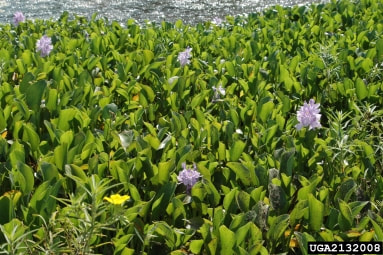|
Water Hyacinth
Eichhornia crassipes Originally from the Amazon basin, water hyacinth is known to be one of the fastest growing aquatic plants in the world. Spreading through both seed and horizontal stems, new plants can easily grow from an existing population or be spread to new areas via fragments. With large, waxy leaves (4-8 inches wide) and distinct purple/white flowers, water hyacinth is not too challenging to identify. That being said, escaped populations are (fortunately) limited in much of Michigan. If spotted, it should be reported immediately.
Water hyacinth is considered a noxious weed species in more than 50 countries. It was first introduced into the United States during the 1884 Cotton States Exposition in New Orleans. The plants were given as gifts to attendees, who later took them home to add to backyard ponds. By 1900, water hyacinths had escaped cultivation and become a serious pest in many southern states (Stop Aquatic Hitchhikers). Once it takes over an area, water hyacinth forms dense mats that completely cover a water's surface. Aquatic species below die and decay, causing a depletion in dissolved oxygen. This in turn decreases the ability for fish and other living organisms to live. Photo credits: Wilfredo Robles, Mississippi State University, Bugwood.org | Chris Evans, University of Illinois, bugwood.org | Barry Rice, sarracenia.com, bugwood.org
Learn More About Water Hyacinth:
|
Water Hyacinth Facts
Management Options
|
|
Created by the Northwest Michigan Invasive Species Network
|
Go Beyond Beauty is funded by the Michigan Invasive Species Grant Program (MISGP)
|







